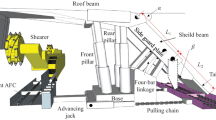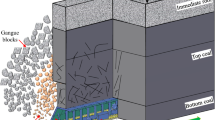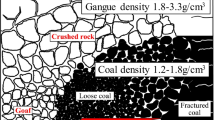Abstract
The size distribution of granular top coal holds great influence on the drawing mechanism in longwall top coal caving (LTCC) panel. In this paper, based on the data observed from the Ruilong mine in Shanxi province, China, the effect of the size distribution of granular top coal on the drawing mechanism was investigated using theoretical analysis, 3D physical simulation and discrete element numerical calculation. The results show that the volume of the drawing body increases linearly with increasing weighted average size of granular top coal, while the maximum width of the drawing body increases nonlinearly; with increasing length of the opening, the drawing volume also increases nonlinearly at a gradually decreasing rate. With the increasing weighted average size of granular top coal, the top coal recovery ratio of the panel increases first and then decreases, and when the weighted average size of granular top coal is in the range of 150–250 mm, the recovery ratio is higher. A situation in which the size distribution of granular top coal is relatively dispersed and the standard deviation is larger is more conducive to the granular top coal drawing in the working face. When the percent of small particle is larger, the top coal recovery ratio decreases with increasing length of the opening, and it is suggested to use a single opening; in contrast, when the percent of large size particles is larger, the top coal recovery ratio increases first and then remains at a certain level, and it is suggested to use a double opening. Suggested measurements are proposed to improve top coal recovery in LTCC panel based on the research results.























Similar content being viewed by others
Abbreviations
- a, b, c :
-
Linear sizes of granular top coal in three directions (mm)
- DBn:
-
The nth drawing body in PFC calculation
- d c :
-
Size of granular top coal (mm)
- d cwav :
-
Weighted average size of granular top coal (mm)
- D p :
-
Diffusion coefficient
- k :
-
Constraint coefficient of the boundary of granular top coal
- L o :
-
Length of the support opening (mm)
- m c :
-
Initial mass of granular top coal (g)
- m cd :
-
Mass of drawn granular top coal of working face (g)
- m rd :
-
Mass of drawn rock particles of working face (g)
- MKAS:
-
Manual turn knob for advancing support
- MKOCO:
-
Manual turn knob for opening and closing support opening
- n :
-
Number of supports
- N :
-
Number of drawn marked particles
- N n :
-
Number of drawn marked particles on the top of support no. n
- N 0 :
-
Initial number of marked particles on the top of each support before drawing granular top coal
- n t :
-
Total number of supports
- Q 1 :
-
Volume of the drawing body at the first drawing (cm3)
- Q 3 :
-
Volume of the drawing body at the third drawing (cm3)
- Q av(DB03-12) :
-
Average volume of DBn (n = 3–12) in PFC calculation (m3)
- Q c :
-
Initial volume of granular top coal (cm3)
- Q cd :
-
Volume of drawn granular top coal of working face (cm3)
- Q DBn :
-
Volume of DBn in PFC calculation (m3)
- Q rd :
-
Volume of drawn rock particles of working face (cm3)
- Q t :
-
Volume of drawn particles during period t in theoretical analysis (m3)
- R 2 :
-
Correlation coefficient
- SDT:
-
Size distribution of granular top coal
- T :
-
Drawing time of working face (s)
- V x :
-
Velocity of particles along the x direction
- V y :
-
Velocity of particles along the y direction
- V z :
-
Velocity of particles along the z direction
- w 0max :
-
Maximum width of the drawing body in theoretical analysis (m)
- w :
-
Mass percentage (%)
- w c :
-
Cumulative mass percentage (%)
- W o :
-
Width of the support opening (mm)
- z 0 :
-
Coordinates of particle when t = 0 in kinematic model in theoretical analysis (m)
- z 0max :
-
Maximum height of the drawing body in theoretical analysis (m)
- η n :
-
Top coal recovery ratio of support no. n (%)
- η nav :
-
Average of ηn (%)
- η w :
-
Top coal recovery ratio of working face (%)
- ρ b :
-
Bulk density (g/cm3)
- μ :
-
Proportionality coefficient
References
Lan, Y.W., Gao, R., Yu, B., Meng, X.B.: In situ studies on the characteristics of strata structures and behaviors in mining of a thick coal seam with hard roofs. Energies. 11, 2470 (2018)
Yasitli, N.E., Unver, B.: 3D numerical modeling of longwall mining with top-coal caving. Int. J. Rock Mech. Min. Sci. 42, 219–235 (2005)
Unver, B., Yasitli, N.E.: Modelling of strata movement with a special reference to caving mechanism in thick seam coal mining. Int. J. Coal Geol. 66, 227–252 (2006)
Vakili, A., Hebblewhite, B.K.: A new cavability assessment criterion for longwall top-coal caving. Int. J. Rock Mech. Min. Sci. 47, 1317–1329 (2010)
Basarir, H., Oge, I.F., Aydin, O.: Prediction of the stresses around main and tail gates during granular top coal caving by 3D numerical analysis. Int. J. Rock Mech. Min. Sci. 76, 88–97 (2015)
Likar, J., Medved, M., Lenart, M., Mayer, J., Malenković, V., Jeromel, G., Dervarič, E.: Analysis of geomechanical changes in hanging wall caused by longwall multi top caving in coal mining. J. Min. Sci. 48, 135–145 (2012)
Jeromel, G., Medved, M., Likar, J.: An analysis of the geomechanical processes in coal mining using the Velenje mining method. Acta. Geotech. Slov. 7, 31–45 (2010)
Melo, F., Vivanco, F., Fuentes, C., Apablaza, V.: On drawbody shapes: from Bergmark-Roos to kinematic models. Int. J. Rock Mech. Min. Sci. 44, 77–86 (2007)
Melo, F., Vivanco, F., Fuentes, C., Apablaza, V.: Kinematic model for quasi static granular displacements in block caving: dilatancy effects on drawbody shape. Int. J. Rock Mech. Min. Sci. 45, 248–259 (2008)
Jin, A.B., Sun, H., Wu, S.C., Gao, Y.T.: Confirmation of the upside-down drop shape theory in gravity flow and development of a new empirical equation to calculate the shape. Int. J. Rock Mech. Min. Sci. 92, 91–98 (2017)
Sun, H., Gao, Y.T., Elmo, D., Jin, A.B., Wu, S.C., Dorador, L.: A study of gravity flow based on the upside-down drop shape theory and considering rock shape and breakage. Rock Mech. Rock Eng. 7, 1–13 (2018)
Song, Z.Y., Wei, W.J., Zhang, J.W.: Numerical investigation of effect of particle shape on isolated extracted zone (IEZ) in block caving. Arab. J. Geosci. 11, 310 (2018)
Yu, B., Zhao, J., Xiao, H.: Case study on overburden fracturing during longwall granular top coal caving using microseismic monitoring. Rock Mech. Rock Eng. 50, 507–511 (2017)
Wang, J.C., Zhang, J.W.: BBR study of top-coal drawing law in longwall top-coal caving mining. J. China Coal Soc. 40, 487–493 (2015)
Wang, J.C., Zhang, J.W., Li, Z.L.: A new research system for caving mechanism analysis and its application to sublevel top-coal caving mining. Int. J. Rock Mech. Min. Sci. 88, 273–285 (2016)
Orlando, A.D., Shen, H.H.: Effect of particle size and boundary conditions on the shear stress in an annular shear cell. Granul. Matter 14, 423–431 (2012)
Jiang, M.D., Yang, Z.X., Barreto, D., Xie, Y.H.: The influence of particle-size distribution on critical state behavior of spherical and non-spherical particle assemblies. Granul. Matter 20, 80 (2018)
Wang, J.C., Li, Z.G., Chen, Y.J., Zheng, H.F.: The experimental study of loose medium flow field on the longwall top-coal caving. J. China Coal Soc. 29, 260–263 (2004)
Cao, S.G., Guo, J.G., Ye, Y.G.: Analysis on coal size influenced to caving output rate. Coal Sci. Technol. 32, 61–63 (2004)
Zhang, Y., Si, Y.L., Shi, L.: Numerical simulation of the effect of particle size on coal caving ratio. J. Min. Saf. Eng. 28, 247–251 (2011)
Zhou, R.X.: Loose Material Mechanics. China University of Mining and Technology Press, Xuzhou (1995)
Wang, J.C., Zhang, J.W., Wang, Z.H.: Basic Theories and Application in Top-Coal Caving Mining. Science Press, Beijing (2018)
Zhang, Y., Wei, Y.F., Peng, Z., Jiang, Y.M., Duan, W.S., Hou, M.Y.: Inclined glass-sand flow and the angle of repose. Acta Phys. Sin. 65, 211–218 (2016)
Zhang, J.W., Wang, J.C., Wei, W.J., Chen, Y., Song, Z.Y.: Experimental and numerical investigation on coal drawing from thick steep seam with longwall top coal caving mining. Arab. J. Geosci. 11, 96 (2018)
Wang, J.C., Song, Z.Y., Zhang, J.W., Chen, Y.: Theoretical model of drawing body in LTCC mining. J. China Coal Soc. 41, 352–358 (2016)
Zhang, J.W., Wang, J.C., Wei, W.J.: Effect of face dip angle on the drawing mechanism in longwall top-coal caving mining. J. China Univ. Min. Tech. 47, 805–814 (2018)
Wang, W.G., Zhou, Z.G., Zong, J., Hou, M.Y.: DEM simulation of the granular maxwell’s demon under zero gravity. EPJ Web Conf. 140, 1–4 (2017)
Wang, G.F., Zhang, D.S.: Innovation practice and development prospect of intelligent fully mechanized technology for coal mining. J. China Univ. Min. Tech. 47, 459–467 (2018)
Acknowledgements
This study was funded by the National Key R&D Plan of China [Grant No. 2018YFC0604501]; the Natural Science Foundation of China [Grant No. 51674264, 51574244]; and China Postdoctoral Science Foundation [Grant No. 2018M631622, 2019T120153].
Author information
Authors and Affiliations
Corresponding author
Ethics declarations
Conflict of interest
We declare that we have no financial and personal relationships with other people or organizations that can inappropriately influence our work, there is no professional or other personal interest of any nature or kind in any product, service and/or company that could be construed as influencing the position presented in, or the review of, this manuscript.
Additional information
Publisher's Note
Springer Nature remains neutral with regard to jurisdictional claims in published maps and institutional affiliations.
Rights and permissions
About this article
Cite this article
Wang, J., Wei, W. & Zhang, J. Effect of the size distribution of granular top coal on the drawing mechanism in LTCC. Granular Matter 21, 70 (2019). https://doi.org/10.1007/s10035-019-0923-5
Received:
Published:
DOI: https://doi.org/10.1007/s10035-019-0923-5




